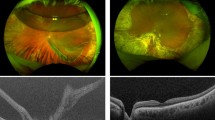Abstract
Background
Silicone oil (SO) is a long-term tamponade for repair of complex retinal pathology but has limitations including late redetachment. This study describes our experience with SO tamponade for repair of retinal detachment with proliferative vitreoretinopathy (PVR), with attention to anatomic and functional outcomes.
Methods
Retrospective consecutive case series of eyes with retinal detachment (RD) complicated by proliferative vitreoretinopathy (PVR) receiving SO tamponade at the University of Wisconsin between 2013 and 2019. Group 1 defined as primary SO placement; Group 2 had SO placed after failing prior retinal detachment repair.
Results
Inclusion criteria of SO placement for repair of RD with PVR was met for 117 eyes. The final reattachment rate was 84% for all eyes, with no difference between Groups 1 and 2. Vision improvement was 2.1 lines for Group 1 (p = 0.06 from baseline) and 4.6 lines for Group 2 (p < 0.0001). The mean number of silicone oil placements was 1.4. Less improvement in vision was noted with repeat SO placement, though overall functional vision of 5/200 or better was achieved in 63.2% of patients.
Conclusions
SO tamponade allows long-term anatomical stabilisation and substantial vision recovery in eyes with retinal detachment complicated by PVR. Rates of anatomic and functional success have improved significantly when compared to prior studies using oil tamponade for repair of PVR.
This is a preview of subscription content, access via your institution
Access options
Subscribe to this journal
Receive 18 print issues and online access
$259.00 per year
only $14.39 per issue
Buy this article
- Purchase on Springer Link
- Instant access to full article PDF
Prices may be subject to local taxes which are calculated during checkout


Similar content being viewed by others
Data availability
Raw data for the dataset in Tables 1,2,3 are not publicly available to preserve individuals’ privacy under the Health Insurance Portability and Accountability Act. The data that support the findings of this study may be shared with an IRB approved Data Use Agreement with the University of Wisconsin with request made to the corresponding author. Data are located in controlled access data storage at the University of Wisconsin.
References
Cibis PA, Becker B, Okun E, Canaan S. The use of liquid silicone in retinal detachment surgery. Arch Ophthalmol. 1962;68:590–9.
Lean J, Boone D, Azen S, Lai M, Linton K, McCuen B, et al. Vitrectomy with silicone oil or sulfur hexafluoride gas in eyes with severe proliferative vitreoretinopathy: results of a randomized clinical trial. Silicone Study Report 1. Arch Ophthalmol. 1992;110:770–9.
Schwartz SG, Flynn HW Jr, Wang X, Kuriyan AE, Abariga SA, Lee WH. Tamponade in surgery for retinal detachment associated with proliferative vitreoretinopathy. Cochrane Database Syst Rev. 2020;5:Cd006126.
Iyer SSR, Regan KA, Burnham JM, Chen CJ. Surgical management of diabetic tractional retinal detachments. Surv Ophthalmol. 2019;64:780–809.
Feng X, Li C, Zheng Q, Qian XG, Shao W, Li Y, et al. Risk Of Silicone Oil As Vitreous Tamponade In Pars Plana Vitrectomy: A Systematic Review and Meta-Analysis. Retina. 2017;37:1989–2000.
De Juan E Jr, BW McCuen 2nd. Management of anterior vitreous traction in proliferative vitreoretinopathy. Retina. 1989;9:258–62.
Lewis H, Aaberg TM, Abrams GW. Causes of Failure After Initial Vitreoretinal Surgery for Severe Proliferative Vitreoretinopathy. AmJOphthalmol. 1991;111:8–14.
Boeke PS, Altaweel MM. Reservoir Technique: A Novel Method for Pressure-Controlled Silicone Oil Infusion Using the Constellation Vitrectomy System. Retina. 2022;42:1211–3.
McCuen BW 2nd, Azen SP, Stern W, Lai MY, Lean JS, Linton KL, et al. Vitrectomy with silicone oil or perfluoropropane gas in eyes with severe proliferative vitreoretinopathy. Silicone Study Report 3. Retina. 1993;13:279–84.
Lange C, Feltgen N, Junker B, Schulze-Bonsel K, Bach M. Resolving the clinical acuity categories “hand motion” and “counting fingers” using the Freiburg Visual Acuity Test (FrACT). Graefes Arch Clin Exp Ophthalmol. 2009;247:137–42.
Eliott D, Stryjewski TP, Andreoli MT, Andreoli CM. Smoking Is A Risk Factor For Proliferative Vitreoretinopathy After Traumatic Retinal Detachment. Retina. 2017;37:1229–35.
Xu K, Chin EK, Bennett SR, Williams DF, Ryan EH, Dev S, et al. Predictive Factors For Proliferative Vitreoretinopathy Formation After Uncomplicated Primary Retinal Detachment Repair. Retina. 2019;39:1488–95.
McCuen B, Azen S, Boone D, Lai M, Lean J, Linton K, et al. Vitrectomy with silicone oil or perfluoropropane gas in eyes with severe proliferative vitreoretinopathy: results of a randomized clinical trial. Silicone Study Report 2. Arch Ophthalmol. 1992;110:780–92.
Funding
Supported by an unrestricted grant from Research to Prevent Blindness, the McPherson Eye Research Institute Monroe E. Trout Chair (Dr. Altaweel), and a National Eye Institute Vision Research Core Grant (P30 EY016665) to the University of Wisconsin Department of Ophthalmology and Visual Sciences.
Author information
Authors and Affiliations
Contributions
KRS: design of protocol, data extraction and interpretation, manuscript writing, literature search. MJW and PSB: design of protocol, data extraction. MIP, JSC, JLG, and TMN: data interpretation, manuscript revision. MMA: design of protocol, data interpretation, manuscript revision.
Corresponding author
Ethics declarations
Competing interests
The authors declare no competing interests.
Additional information
Publisher’s note Springer Nature remains neutral with regard to jurisdictional claims in published maps and institutional affiliations.
Rights and permissions
Springer Nature or its licensor (e.g. a society or other partner) holds exclusive rights to this article under a publishing agreement with the author(s) or other rightsholder(s); author self-archiving of the accepted manuscript version of this article is solely governed by the terms of such publishing agreement and applicable law.
About this article
Cite this article
Schildroth, K.R., Wingelaar, M.J., Boeke, P.S. et al. The Wisconsin silicone oil study (report #1): anatomical and functional outcomes of repair of retinal detachment with proliferative vitreoretinopathy. Eye (2024). https://doi.org/10.1038/s41433-024-03109-x
Received:
Revised:
Accepted:
Published:
DOI: https://doi.org/10.1038/s41433-024-03109-x



